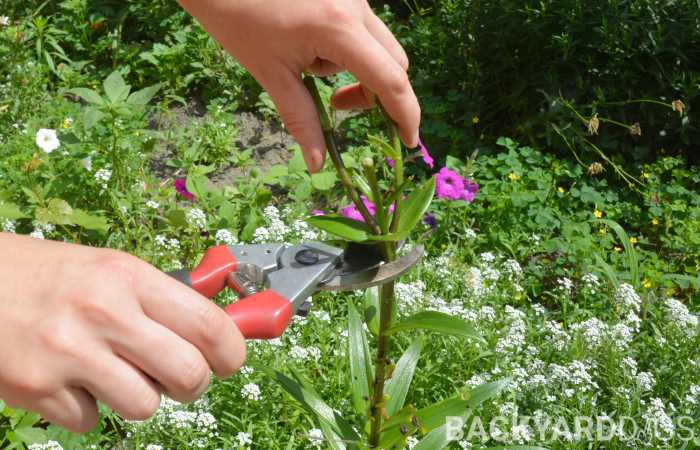Do you love daylilies and wonder if there’s a way to improve blooming during the summer months?
While some daylily varieties boast a longer bloom time than others, there are ways to increase a daylily’s display of colorful flowers.

So, if you want to know how to keep daylilies blooming all summer, continue reading! In this guide, I discuss how long daylilies typically bloom and give you pointers on how to deadhead all varieties.
Once you know the best way to tend to your daylilies, you can increase the beauty they bring to your home’s landscape.
Do Daylilies Bloom All Summer?
Most daylily varieties begin blooming in May or June and display a constant show of flowers for three to four weeks.
In the United States, daylilies thrive in USDA planting zones four through nine, but, they can grow in any region.
There are daylily varieties that produce flowers for an entire season, like the ‘Apricot Sparkles‘ which blooms until the first frost. For those living in the far northern regions, this means you can enjoy colorful flowers for about three months.
I live in a southern region along the Gulf of Mexico and have a hedge of the Apricot Sparkles that bloom from March through December.
Once our region gets a few near-freezing nights, they stop flowering, but most of the foliage remains green for quite some time. This daylily puts out an impressive amount of visual value for most of the year!
If you want your garden to have daylilies blooming all summer, you can plant a mix of varieties that flower early, mid-summer, and late. This method adds a colorful punch to your garden while reducing the need for you to prune your daylilies to extend flowering time.
How To Deadhead Daylilies
As the name daylily implies, their bloom opens in the morning and begins to wither that night. Most flower stalks grow with multiple buds, so when one flower dies, another is ready to open.
The best way to encourage new blossoms to form is to spend time pruning daylilies every few days throughout the summer.
The term deadheading is a bit misleading when it comes to daylilies since it implies pruning just the top of the flower stalk.
Follow these steps for proper daylily pruning:
Step 1. Inspect your daylily stalks, searching out the ones where all the flower buds are open/gone.
Step 2. Using sharp gardening shears, such as Fiskars Steel Bypass Pruning Shears, to snip the stalk around two inches from the bottom of the plant. Trim any dead or damaged leaves you see as well.
Step 3. Take the cut stalks and leaves and add them to your compost pile or bin.
TIP: If you have the patience, try this trick that I use to repurpose those stalks immediately.
Take the shears and snip each stalk into inch-long pieces and spread a thin layer around the base of the daylily foliage and other plants nearby. Instant mulch/fertilizer!
Be careful not to create a thick pile, which could end up forming mold. By spreading the stem material out, the air and moisture can break the pieces down quickly without damaging your plants.
Related | Best Grass Shears
The Benefits of Daylilies in Your Garden
Daylilies create an awesome flower border, a ground cover for slopes or hard-to-manage areas, and work as a backdrop to showcase shorter flowering plants in front.
There are dwarf daylily varieties that grow a mere foot tall, while others can reach upwards of four feet!
The best part about adding daylilies to your garden is the ability to create a true masterpiece of color and eye-catching interest.
Daylilies have been cultivated to grow such amazing shades of flowers, in different heights, with varying times of bloom. These features make it easy to build the perfect landscape design just by using daylilies alone.
When shopping for daylilies, look for descriptors such as:
- Miniature (growth between 12-18 inches)
- Dormant (foliage dies off completely in winter)
- Reblooming
Diploid
Tetraploid
- Tetraploid
- Evergreen/Semi-Evergreen (foliage stays through winter)
Knowing these terms will assist you in purchasing the optimal size and type for your location.
I love how this perennial requires little work as it fills in more each year. Soon you have a dense mass of foliage that deters weed growth and attracts butterflies, hummingbirds, and bees.
You can choose to let the blooms die off naturally and leave the stalks intact. Seed pods will form over the summer season, and by fall, will burst open so new plants will grow come springtime.
Pruning daylilies is also an option, which I discuss further in the deadheading section below.
In Summary
Daylilies are low-maintenance, highly-attractive flowering perennials that everyone can appreciate.
There’s no need to enjoy your daylily blooms for only a few weeks. Now you know the methods avid gardeners like me use to extend the flowering of their daylilies.
You can choose to keep your daylilies blooming all summer by diligent pruning or by planting a variety of species.
Whichever you choose, I’m confident this guide will help you keep colorful daylily blooms popping up all season!










